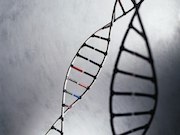Genome-wide association study identified novel signal near GABRR1, which was not seen in Asians
FRIDAY, May 4, 2018 (HealthDay News) — A novel signal has been identified that is associated with microalbuminuria in Europeans with type 2 diabetes (T2D), according to a study published online April 27 in Diabetes.
Natalie R. van Zuydam, Ph.D., from the University of Oxford in the United Kingdom, and colleagues conducted a genome-wide association study (GWAS) of diabetic kidney disease (DKD) in T2D using eight complementary dichotomous and quantitative DKD phenotypes. The dichotomous analysis included 5,717 T2D subjects, of whom 3,345 had DKD. Promising correlation signals were assessed in up to 26,827 subjects with T2D, of whom 12,710 had DKD. A combined T1D+T2D GWAS was performed, which included up to 40,340 subjects with diabetes and 18,582 DKD cases.
In European T2D cases, the researchers identified a novel signal near GABRR1, which was associated with microalbuminuria. This signal was not replicated in Asian subjects with T2D or in the T1D analysis. In this enlarged analysis, there was limited support for the association at previously-reported DKD signals, except for those at UMOD and PRKAG2, which were associated with estimated glomerular filtration rate.
“Despite challenges in addressing phenotypic heterogeneity, access to increased sample sizes will continue to provide more robust inference regarding risk-variant discovery for DKD,” the authors write.
Several authors disclosed financial ties to the pharmaceutical industry.
Copyright © 2018 HealthDay. All rights reserved.








